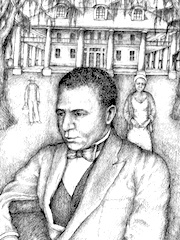|
J. William T. "Bill" Youngs, American Realities, Volume Two:
Historical Episodes from Reconstruction to the Present, Chapter Two |
Booker T. Washington, courtesy of the Library of Congress
|
2. Beyond Emancipation
|
SummaryThe long ordeal of slavery came to an end in 1865 for four million African Americans. Suddenly the freedom they had longed for during two centuries of bondage was theirs. The world opened before them: they could freely visit loved ones, attend schools, or run for public office. Blacks soon realized, however, that chains other than slavery still held them. Penniless, they could not afford to buy farms; untrained, they could not move into better jobs. In the 1870s and 1880s, they lost many of the privileges they had gained when freed, including the right to vote. Booker T. Washington grew to maturity in years when blacks experienced both the exhilaration of freedom and the humiliation of segregation. He proved in his early life that an ex-slave could prosper by hard work. When in his later years he saw the cords of prejudice tightening around his people, he responded in the best way he knew, advocating self-help in the face of prejudice and segregation.
|
Author reads from the Text
As the parade moved through the streets of Atlanta on its way to the opening of the Cotton States Exposition, Booker T. Washington, riding in a carriage near the end of the procession, was deeply troubled. He was a black man who would soon address a white audience, and in the South of 1895 he could not be certain of a friendly reception. Washington’s fears contrasted strangely with the jubilation around him. Here in a city that Sherman had laid in ruins only thirty years before, the buildings were decorated with American flags, and the citizens stood cheering a parade that symbolized the birth of a “new South.” The procession ahead of Washington moved proudly along: white dignitaries in fine carriages, military officers glittering with gold trim and white helmets, rows of soldiers marching with bayonets gleaming in the sun, and a cannon rumbling jauntily over rough cobblestones.
Sitting in the hot sun at the back of this long parade with a cluster of African American soldiers and dignitaries, Washington felt the courage drain from his body. Thousands of blacks lining the road cheered when they saw him. But while their hands reached out to encourage him, they seemed to burden him with a heavy responsibility. How could he speak in a manner that would please whites while doing justice to his own race?
The Atlanta Exposition had been designed to celebrate the achievements of both races. But blacks had been accepted grudgingly. The committee that had invited Washington to speak had done so reluctantly, anticipating at first that he would take part only in the opening of a separate “Negro Building.” Although Washington was belatedly included in the opening day ceremonies, his people would be segregated into a “jim crow” section of the auditorium, just as their exhibits were segregated in a separate hall. Booker T. Washington knew that he could easily alienate the whites and damage his people if he spoke carelessly. If he simply flattered the whites, however, he would let down his black supporters.
Sitting in the hot sun at the back of this long parade with a cluster of African American soldiers and dignitaries, Washington felt the courage drain from his body. Thousands of blacks lining the road cheered when they saw him. But while their hands reached out to encourage him, they seemed to burden him with a heavy responsibility. How could he speak in a manner that would please whites while doing justice to his own race?
The Atlanta Exposition had been designed to celebrate the achievements of both races. But blacks had been accepted grudgingly. The committee that had invited Washington to speak had done so reluctantly, anticipating at first that he would take part only in the opening of a separate “Negro Building.” Although Washington was belatedly included in the opening day ceremonies, his people would be segregated into a “jim crow” section of the auditorium, just as their exhibits were segregated in a separate hall. Booker T. Washington knew that he could easily alienate the whites and damage his people if he spoke carelessly. If he simply flattered the whites, however, he would let down his black supporters.
To see an American Realities blog post on Booker T. Washington and the Hampton Institute
graduation ceremony of 1875, including images and music click here.
graduation ceremony of 1875, including images and music click here.

